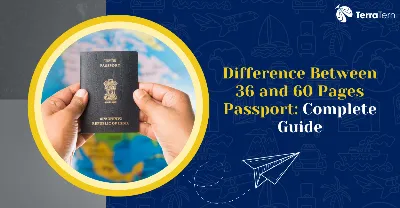Key Highlights
- Understanding the Basic Difference Between 36 Pages and 60 Pages Passport in 2025
- Which Passport Type Should You Choose: 36 vs 60 Pages?
- Current Passport Application Process for Both 36 and 60 Page Options
- Renewal and Replacement Costs for Different Passport Types in 2025
- Latest Special Considerations and Eligibility Criteria
- Latest Facts & News (2025)
- Conclusion
It may not make much of a difference between 36 and 60 pages passport, but it surely can make a big difference between 36 and 60 pages passport in the convenience of travel, the costs, and the frequency of renewing them for you. First-time applicants or persons seeking to reissue their passports can take advantage of the strengths and weaknesses of the two types of passports to make a concrete decision.
Understanding the Basic Difference Between 36 Pages and 60 Pages Passport in 2025

The Government of India issues both a 36-page passport and a 60-page passport, colloquially called a jumbo passport, to support the diverse needs of Indian nationals.
These two may be used to serve the same purpose, and both are valid in international travel, but several significant difference between 36 pages and 60 pages passport may assist you in concluding which one of them may fit your needs better.
1. Usability and Visas Pages
The 33-page passport has 33 working pages divided to accommodate a visa and immigration stamp sticker. Conversely, the passport with 60 pages provides customers with 57 pages to use, leaving three pages free instead of the 24-page version, which is bound to satisfy the frequent flyers.
2. Validity Period
The two passports are issued to an adult applicant with a conventional 10-year validity tenure. In the case of minors, this will be valid for 5 years or until the young person reaches the age of 18 years, whichever happens earlier, conforming to international laws on child travel.
3. Physical Looks and Features
The difference between 36 and 60 pages passport is not visible in size, cover, or layout. The two use identical blue covers with the national emblem and contain the most up-to-date protective measures consisting of microprinting, holographs, and watermarks to foil tampering or reproduction.
4. Goal and Appropriateness
The 36-page passport suits on and off travellers and includes people who travel abroad once or twice a year on vacation or business purposes. In the meantime, the jumbo passport has 60 pages. Who should use this jumbo passport? Busy international travellers like business experts, school kids studying overseas, and citizens working abroad would be better off with a jumbo passport.
Summary of key difference between 36 and 60 pages passport:
|
Feature |
36- Page Passport |
60- Page Passport (Jumbo) |
|
Usable Visa Pages |
33 |
57 |
|
Validity (Adults) |
10 years |
10 years |
|
Validity (Minors) |
5 years or until age 18 |
5 years or until age 18 |
|
Physical Size and Cover |
Same as 60- page |
Same as 36-page |
|
Cost |
INR 1,500 (Normal) |
INR 2,000 (Normal) |
|
Best For |
Occasional travellers |
Frequent international travellers |
In short, the difference between 36 pages and 60 pages passport is primarily about capacity and cost. If you rarely travel abroad, the 36-page version should suffice. But if you anticipate multiple visa stamps over the years, investing in the 60-page jumbo passport can save you from reapplying frequently.
Latest Price Difference Between 36 Page and 60 Page Passport in 2025
The price difference between 36 page and 60 page passport lies in key factors such as the age of the applicant (adult or minor), need (is the speed of his demand immediate), and the kind of service to be availed- regular standard processing or the Tatkal processing.
In most cases, the 60-page passport is a little more expensive than the 36-page passport since it contains additional pages to stamp visas and immigration codes that spare frequent travelers the hassle of replacing their passports. Tatkal processing is an extra service provided at extra charges by both types of passports, as sometimes it doubles the price charged on ordinary passports to satisfy the needs of applicants who need their passports urgently.
Besides, the fee paid by minors is usually lower than that of adults; however, minor children can choose between 36-page and 60-page passports, depending on their travel plans.
Knowing these difference between 36 and 60 pages passport will enable the applicant to make a wise choice in determining whether they are best suited to select the type of passport and how soon they will need it, depending on the budget allocation and frequency, without asking or wondering about the price difference between 36 page and 60 page passport.
Fee Structure Table:
|
Passport Type |
Normal Fee (INR) |
Tatkal Fee (INR) |
|
36-page passport (Adult) |
1,500 |
3,500 |
|
60-page passport (Adult) |
2,000 |
4,000 |
|
36-page passport (Minor) |
1,000 |
3,000 |
|
60-page passport (Minor 15-18) |
1,500 |
3,500 |
Key points of the difference between 36 and 60 pages passport:
-
A 60-page passport is priced at 500 more than a 36-page one.
-
The prices of Tatkal services are standard across all classes, and it is always 2000 rupees extra.
-
The child should be above the age of 15 years; otherwise, they will not get a 60-page passport.
Also Read: What is a File Number in a Passport? Latest Experts Guide
Which Passport Type Should You Choose: 36 vs 60 Pages?

More than 500 rupees separates the difference between a 36-page and 60 60-page passport; it is all about practicality, the way you travel, and convenience. Both passports are equally valid and accepted in every corner of the world as a valid document in international travel; however, the selection you make ought to be an ideal fit for the amount of traveling you commonly do, and the purpose of the trip.
-
What is the difference between 36 and 60 pages passport? It may take no time before your passport pages are covered with the visa stickers and immigration stamps, especially when you are a heavy traveler, usually before the 10-year validity period elapses. Conversely, non-frequent flyers might not use up as few as half of the pages of their 36-page passports in their full scope of validity. This may cause premature passport renewal/reissue, which is time-consuming and costly.
-
Depending on the plans when applying, correctly selecting the passport booklet can initially save a user the trouble of having to reissue a passport too early because the visa pages are filled. It also makes you ready in any travel situation, most noticeably when travelling to countries with a full-page visa sticker or multiple-entry visas that take more pages.
To conclude, you will learn the difference between 36 and 60 pages passport, how often you travel, whether you need any visas, and whether you have any long-term plans, so that you can choose the most advantageous passport booklet in terms of both convenience and economy.
The following are a few quick pointers to make the right decision:
When to Choose 36-Page Passport?
What is the difference between 36 and 60 pages passport? The 36-page passport is most suitable for those who travel less frequently and wish to have an affordable and practical choice, covering their route requirements without superfluous amenities.
Optimal for applicants of 36-page passports
-
Unfrequent Travellers: People who cannot make more than 1-2 international trips annually, usually to sightsee, be among family members, or make short-term business journeys. These travellers do not often require the visa pages; therefore, the 36-page passport will suffice as their travel papers.
-
Inexperienced Travellers: A 36-page passport is cheap, easily affordable, and a good beginning point, especially for new travellers abroad. It contains all the features that the new travellers will need without bombarding them with unnecessary pages that they might not even use.
-
Cost-effective Applicants: The 36-page passport is cheaper by 500 INR compared to the 60-page passport, which is a pocket-friendly option for customers who would like to spend less when traveling without compromising validation and security.
-
Visitors to Visa-Free or e-Visa States: In case you mostly visit visa-free countries or states that provide a visa-trip in the form of an e-visa where stamping of the visa is not vital or does not occur at all, then the 36-page passport is comfortably able to handle this visit because it will not run out of pages.
-
The People Who have Short Term Travelling Plans: The citizens who intend small vacations, shorter student exchange programs or work in a foreign country will not require the 48-page booklet as it contains enough pages that will allow them to obtain 28 visa and immigration stamp pages and it is also adequate to have short term plans that do not require so many pages.
Also Read: What is RPO in Passport? Experts Complete Guide
When to Choose 60-Page Jumbo Passport?

What is the difference between 36 and 60 pages passport? The 60-page jumbo passport fits perfectly the description of any such traveller who crosses in and out of borders internationally and requires a lot of pages since they might have so many visas and immigration stamps and would not want to run out of pages relatively fast.
Most Appropriate When Customer Applicant is 60-Page Jumbo
-
Frequent International Travellers: People taking more than one trip outside the country annually, on whatever basis, business, pleasure, family, etc., will also find the added visa pages helpful. The passport that is 60 pages makes it easy to make travel arrangements and minimizes the need to reissue passports early.
-
Business People who Travel to Various Nations: Individuals who frequently need to travel abroad may be at the border of different countries and need multiple visas and entry marks. For example, business executives, consultants, and sales representatives will likely fall under this category. The bigger booklet allows the freedom of such hectic travel itineraries.
-
Scholars Going Abroad in the Long Run: Some students will study abroad and may need more than one visa or renew their visa during their study duration. The 60-page passport gives them ample space to have all the documentation required during their academic ventures.
-
People who Work in More than one Country: A jumbo passport will come in handy to those who are assigned to international companies and might be relocating quite often or have job orders in more than one country as 3 or 4 visa applications in a month will not be a problem any more (a 28-page passport has a slot dedicated to visas only).
-
Tourists to Countries that Require Full-Page Visas: Other nations, such as the USA, China, and Russia, have visas that occupy the whole page in the passport. With a 60-page passport, you will have the assurance of having more full pages that you can use to place such visas without the fear of exhausting them.
Current Passport Application Process for Both 36 and 60 Page Options
The procedures of applying for a passport with the difference between 36 and 60 pages passport are the same. This is only different in the choice of the type of booklets you would like to use in the application. The regular and the jumbo passports follow the same steps and documentation.
The Process to Apply for Your Passport with the difference between 36 and 60 pages passport:
-
Sign up on the Passport Seva Portal
The first step is creating an account by accessing the official Passport Seva site. An individual must first register, and the process is free.
-
User Name and Password, and Fill in the Passport Application Form
You must log in online after registering and completing the detailed application form. Give correct personal, contact, and address details.
-
Choose the Booklet Type
The passport is available in 36 or 60 pages, depending on your traveling requirements. With this choice, you will decide how many pages you will have in your passport booklet.
-
Following the Above Requirements, Provide the Following Information
Attach the scanned copy of the required document, like the Aadhaar card, address proof, and date of birth proof. In the case of the minors, a birth certificate is required.
-
Payout Applicable Fees
Remit payment of the passport fees through net banking, credit/debit card, or manually at the Passport Seva Kendra (PSK). This cost is based on the kind of passport booklet required and the processing speed (normal or Tatkal).
-
Make an Appointment at the Local PSK or POPSK
Book your facility availability date with the nearest PSK/PSLK Passport Seva to verify the documents and to get their biometric data.
-
Go to the Appointment
Come to the reserved center on your booked date, along with your original documents. This is where your papers will be checked, and a photograph of you, your fingerprints, and your signature will be taken.
-
Track the Status
Check your passport application status by SMS or logging onto your passport Seva portal. This will keep you updated on reception and dispatch information processing.
-
Get Your Passport
After the processing, your passport document will be sent to your registration address through the speed post service; hence, there is assurance of safety and prompt delivery.
Processing Timelines with the difference between 36 and 60 pages passport:
-
Normal Processing: Usually, this can take up to 30 to 45 days after the date of your appointment. This schedule can differ regarding regional demand and clearance procedures.
-
Tatkal Processing: A fast service is available to people with an urgent need to travel, and the passport delivery is within 1 to 3 working days of the appointment. The service has extra charges but ensures the overall process is much faster.
Also Read: Oman Visa on Arrival for Indian Passport Holders
Renewal and Replacement Costs for Different Passport Types in 2025
Image: https://www.pexels.com/photo/white-ceramic-mug-near-white-laptop-computer-2305114/
The cost of renewal and replacement is also difference between 36 and 60 pages passport, as it can be slightly different depending on the type of passport, depending on the case. This knowledge can enable you to plan your passport costs better.
Renewal and Replacement Cost of Various Types of Passports
-
Renewal of Expired Passports
-
If your passport has expired or is more likely to expire, you should renew it. The prices vary according to the type of booklet:
-
36-page passport renewal costs INR 1,500
-
60-page passport renewal costs INR 2,000
-
Reissue/ Repair Fees
-
Should you have a damaged passport, i.e., torn pages or damage caused by water, you must apply to have the same replaced. The cancellation charges are:
-
INR 3,000 for the 36-page passport
-
INR 3,500 for the 60-page passport
-
Replacement Fees for Lost Passports
-
The loss of a passport involves a report to the police, followed by an application for a replacement. The prices are equal to the damaged ones:
-
INR 3,000 for the 36-page passport
-
INR 3,500 for the 60-page passport
-
ECR (Emigration Check Required) Deletion Charges
-
When you meet the standards to get the ECR status lifted from your passport, the fees will be:
-
INR 1,500 for the 36-page passport
-
INR 2,000 for the 60-page passport
Tips on Renewal despite the difference between 36 and 60 pages passport:
-
Renewal Is Not automatic: Passports are not made automatically. To ensure no kink in your plans, you should go out of your way and get the renewal before your current passport runs out.
-
There should be a Police Verification in case of Lost or Damaged Passports: If your passport gets misplaced or damaged, the police verification report is a must, and only then can you proceed with the new passport. It is to avoid misuse or larceny of identity.
-
Start Early: It is also advisable to monitor and ensure that your passport expiry date is renewed at least three months before the expiration date. This buffer time can prevent last-minute slip-ups, especially when further checking is necessary.
What is the difference between 36 and 60 pages passport? Bearing these costs in mind, the procedure enables you to efficiently handle the passport you use at any given time and be ready with every international travel requirement.
Also Read: Can I Change Date of Birth in Passport? Experts Guide
Latest Special Considerations and Eligibility Criteria
The difference between 36 and 60 pages passport have particular rules and eligibility criteria for issuance. These criteria depend on an applicant's age, occupation, purpose of travel, etc. The knowledge of these special considerations enables the applicants to choose the most appropriate passport type that fits their requirements.
Special considerations and eligibility Sections with difference between 36 and 60 pages passport:
1. Age and Type Restriction
-
Underage Children Under 15 Years: Children under 15 are only allowed to apply for the 36-page passport booklet. This restriction will make the process easier for younger travelers, as they usually do not have many international travel requests.
-
Children Between the Ages of 15 and 18 Years: In this category, teenagers can get a 36-page or 60-page passport, given their projected number of travels and the number of visas they expect to use, which makes it convenient to get a passport for this age group. This choice benefits students who can travel longer or more internationally, particularly for educational or other reasons.
-
Senior Citizens (60Years and Above): The Indian Passport fees qualify an Indian citizen 60 years and above for a 10 percent discount in both the 36-page and 60-page passports. This is one of the concessions made by the government to make traveling cheaper for senior citizens.
2. Passport Categories ECR vs Non-ECR
ECR (Emigration Check Required): Mainly, this type concerns workers, whose skills are not only of low quality but who go to particular countries, especially in the Gulf region and some other places. The ECR status also holds the workers to a condition that they must seek permission from the Protector of Emigrants before they go to a foreign country to ensure their safety and sound documentation.
Non-ECR:
- Non-ECR status means the passport holder is not subject to such a requirement as the emigration check. In most cases, it is given to individuals fulfilling specific educational, professional, or financial standards, which include:
- Students who have graduated from an acceptable university graduates
- Taxpayers who pay normal income taxes
- People with formal qualifications, including doctors, engineers, and teachers, are professionals.
3. Other Passport Types
-
Diplomatic Passports: They are only conferred on governmental officials, diplomats, and people acting on behalf of India on official international duties. Diplomatic passports have special privileges and immunities as contained in international agreements.
-
Official Passports: Government employees or individuals travelling abroad on government missions are issued official passports as non-diplomatic. Still, government-sponsored travel passports are required, i.e., when one travels on a government-sponsored trip, attends an international conference, an international government meeting, or an official visit.
What is the difference between 36 and 60 pages passport? These customized rules and eligibility norms will ensure that the appropriate passport is issued per the applicant's profile, the reason for visiting the country, and the legal necessities. By learning the difference between 36 and 60 pages passport, applicants can make proper choices that help them go through the application process more easily and travel internationally without any hassles.
Also Read: Visa on Arrival Philippines for Indian Passport
Latest Facts & News (2025)

-
Indian passport fees remain unchanged in 2025, with a 36-page passport at INR 1,500 and a 60-page passport at INR 2,000
-
New digital passport application process reduces processing time from 45 days to 30 days
-
Over 6.7 million Indians received new passports in 2024, with 65% choosing 36-page variants
-
Tatkal passport services are now available at 400+ centers across India, maintaining the same price structure.
-
Minor passport validity extended to 10 years for ages 15-18, same fees as adults apply
-
E-passports implementation expected by 2026 with enhanced security features.
-
Senior citizens (60+) continue to receive a 10% discount on passport fees.
Conclusion
The question of the difference between 36 and 60 pages passport comes down to the frequency of travel and future intentions. Although the 36-page passport (at 1,500) is inexpensive and handy enough to accommodate light or occasional travellers, the jumbo passport (at 2,000) is more convenient.
It accommodates more pages in case of frequent globe-trotters. Some of the factors you would want to consider before applying include how frequently you travel, what kind of visas you apply for and need regularly, and how much you are willing to pay to have the visa processed or renewed, depending on its type. After all, the purpose of both passports remains unchanged, and their validity duration is equal; the significant difference between 36 and 60 pages passport is the degree of flexibility and the capabilities they offer in dealing with your travel requirements! Contact TerraTern for more information on the difference between 36 and 60 pages passport.






